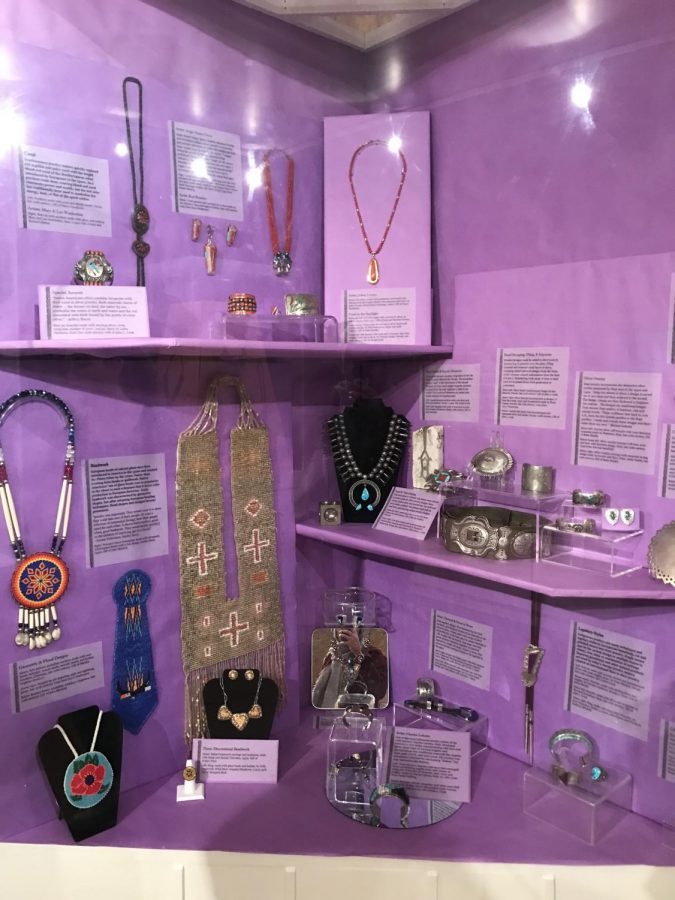New exhibit shows past and present of Native American jewelry
Native American jewelry on display at Evanston’s Mitchell Museum of the American Indian. The exhibit opened Sept. 28
September 30, 2019
Upon entering the warmly-lit space housing the Mitchell Museum of the American Indian’s new exhibit, “Stunning Stories in Native American Jewelry,” attention is first drawn to the subtle gleam of a silver necklace accented with turquoise, encased in the center of the room. Closer inspection shows the faded markings of the dimes and half-dollar coins melted to form this piece of jewelry during World War II, when the practice was revived by Navajo silversmiths after being banned in the 1890s.
“Stunning Stories in Native American Jewelry,” located at 3001 Central St., opened to the public on Sept. 28, featuring nearly 100 pieces of jewelry representing tribes from throughout the U.S. and Canada, with a focus on the Southwest.
“The Mitchell Museum is dedicated to presenting the material culture of a lot of American Indian people,” said Ernest M. Whiteman III, a Northern Arapaho filmmaker and the museum’s education coordinator. “This exhibition represents not only a material culture, but also an art form that is culturally important to Native people.”
Information about materials and techniques opens the exhibition, providing a background to the different types of jewelry on display and the influence of expanding trade and change on them.
One piece that illustrates the blend of Native American symbolism with the influence of Spanish silversmithing techniques is a squash blossom necklace, of which several are on display as part of both “Stunning Stories” as well as the Mitchell Museum’s permanent exhibit. Another section of the exhibit displays pieces made during the Great Depression, using materials such as repurposed vinyl and utensils in lieu of semi-precious stones like jet.
“In developing the exhibit, we reached out to the artists and tribal communities to share their intimate stories of what their prized jewelry means to them- the materials, symbols, and experience making, wearing, and even losing their treasured pieces” Kathleen McDonald, the exhibit curator and museum’s executive director since 2009, said in a news release.
Weinberg first-year Delaney Glassner visited the exhibit on its opening day, and said it was “refreshing” to see artwork that is “often overlooked.”
“It’s unlike anything I’ve seen before in larger museums,” Glassner said. “It’s all new and interesting.”
Particularly captivating in Whiteman III’s eyes is the Storyteller Belt by prominent Alaskan Chugach Aleut jewelry-makers Denise and Sam Wallace, completed in 1992. Intricately set in 14 carat gold, the belt entitled ‘Women and Children’ is elaborate in its depiction of Native American lifeways. It follows Storyteller traditions which began in the 1960s when artists started creating jewelry explicitly depicting Native American lifeways ranging from portraits of Indigenous people to scenes of herding sheep.
A combination of both historical and contemporary works such as the belts is important to the Mitchell Museum’s ethos, Whiteman III said.
“It connects not only the historical aspect of jewelry making but also the contemporary which a lot of institutions do not do,” he added. “The idea that Natives are making a resurgence is wrong. We were always here.”
The museum will host a day of events on Oct. 14 for Indigenous Peoples’ Day, including events for young people and families led by Carol Kramer, Ojibwe.
Email: [email protected]
Twitter: @_ahlaamm


